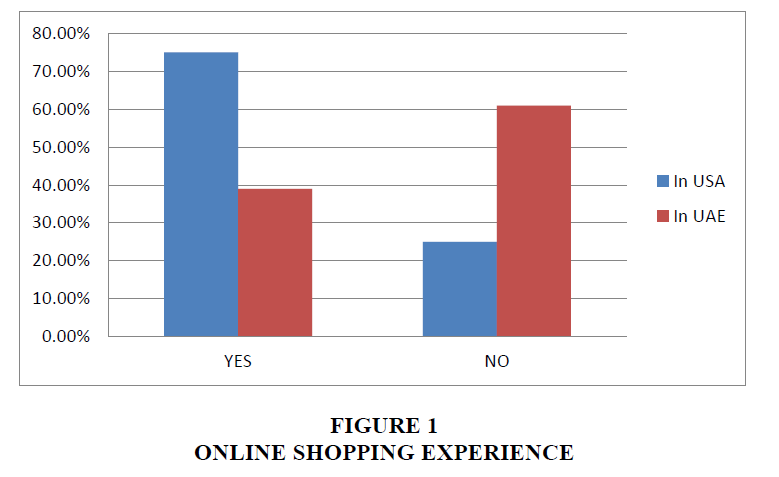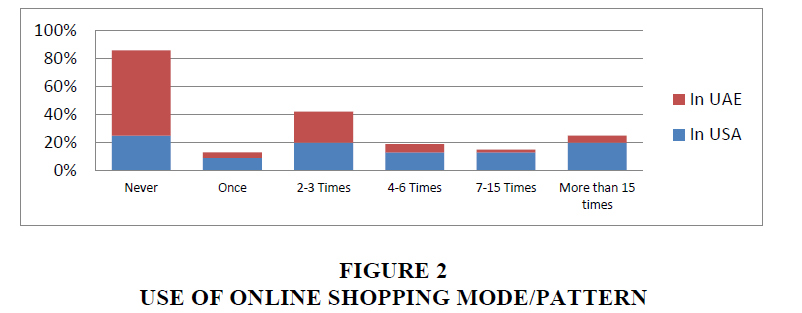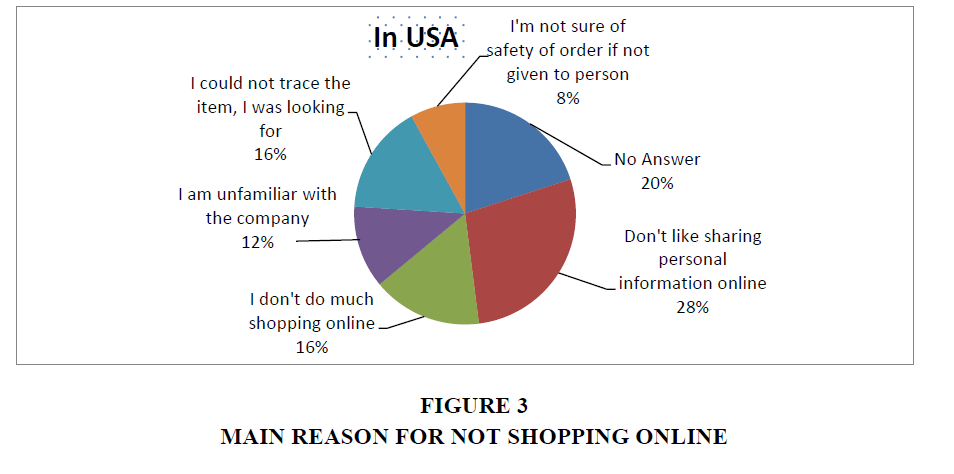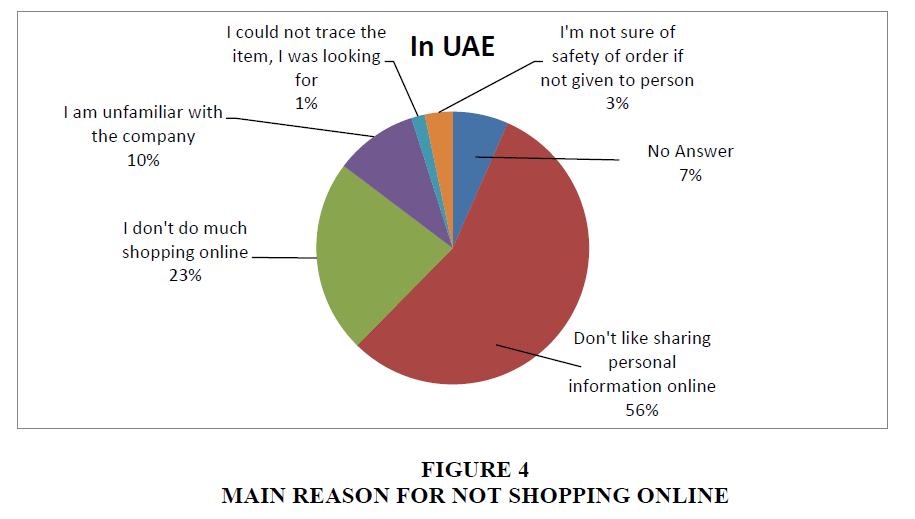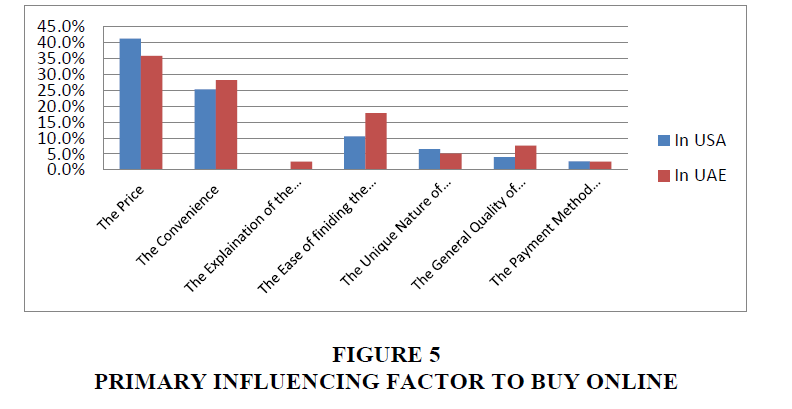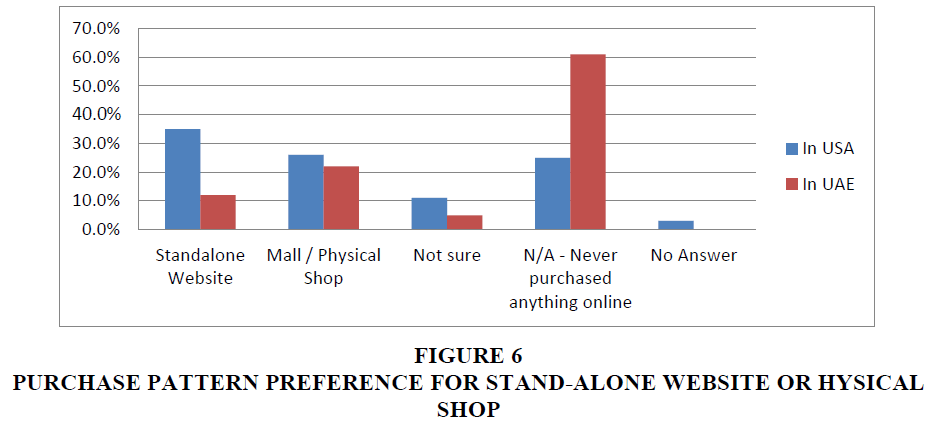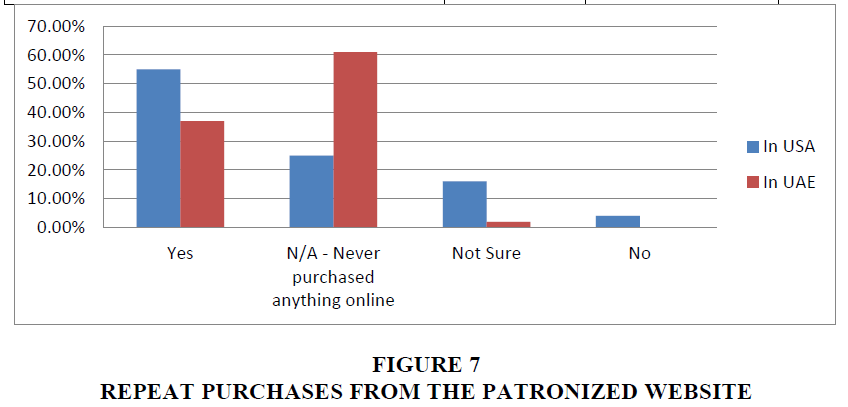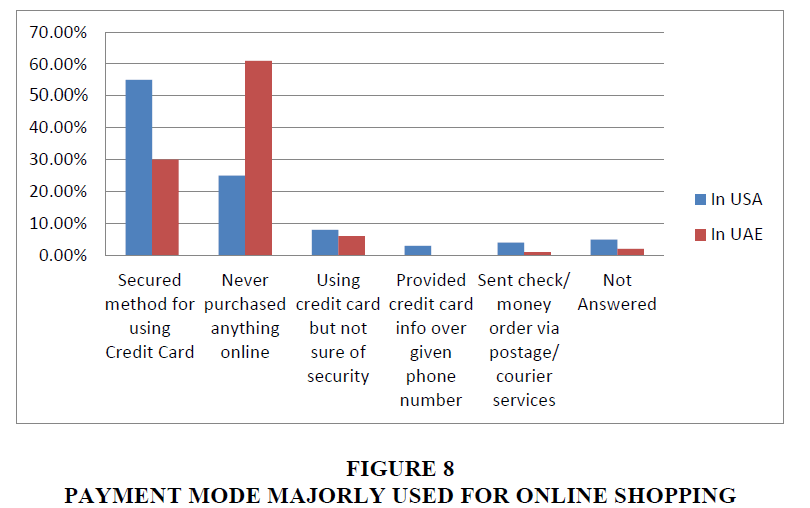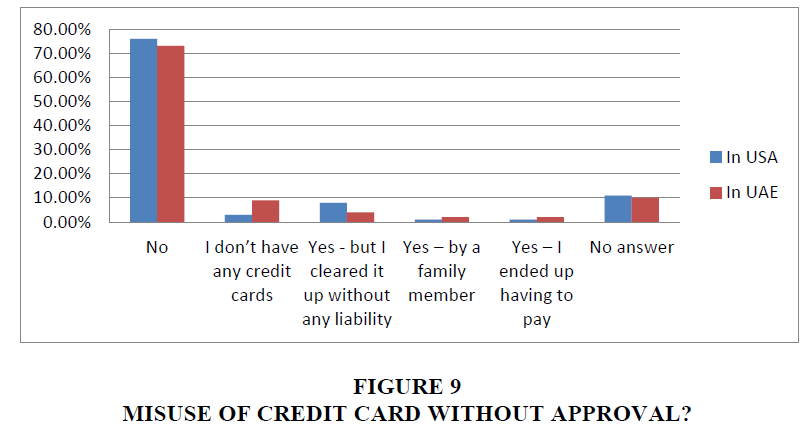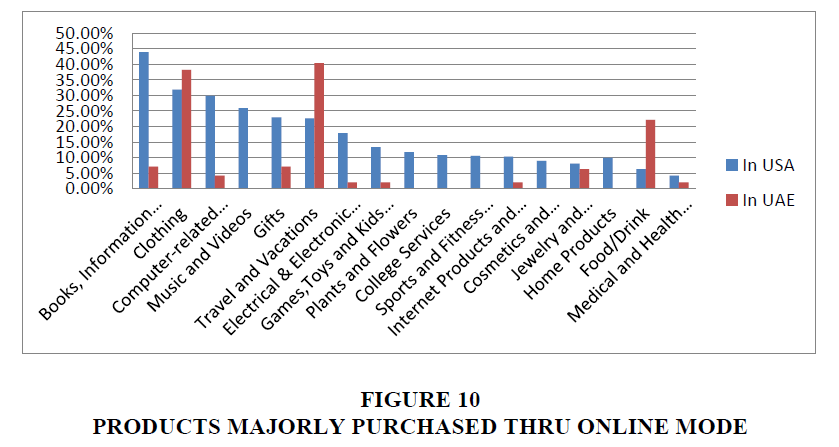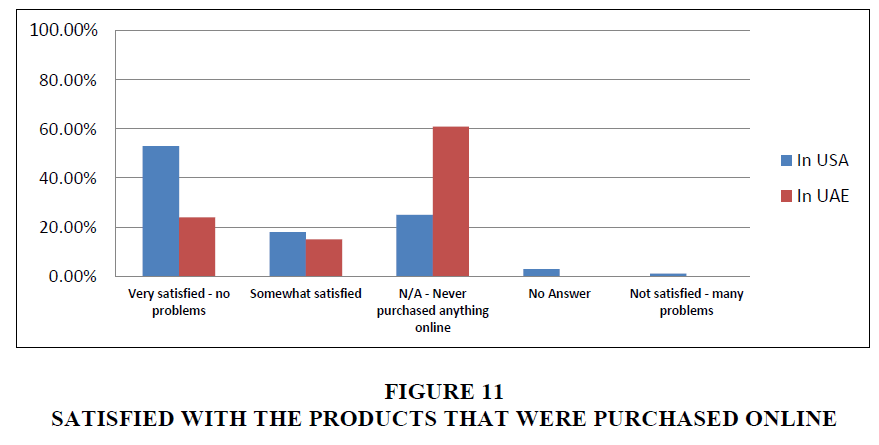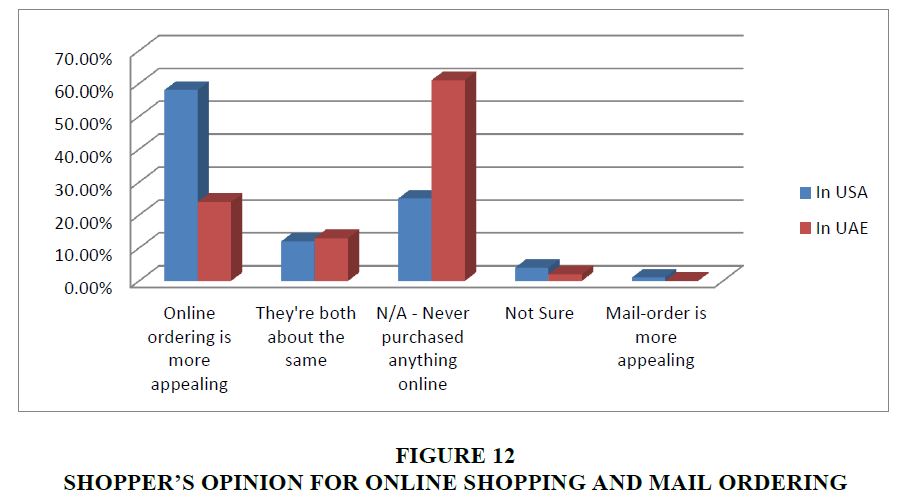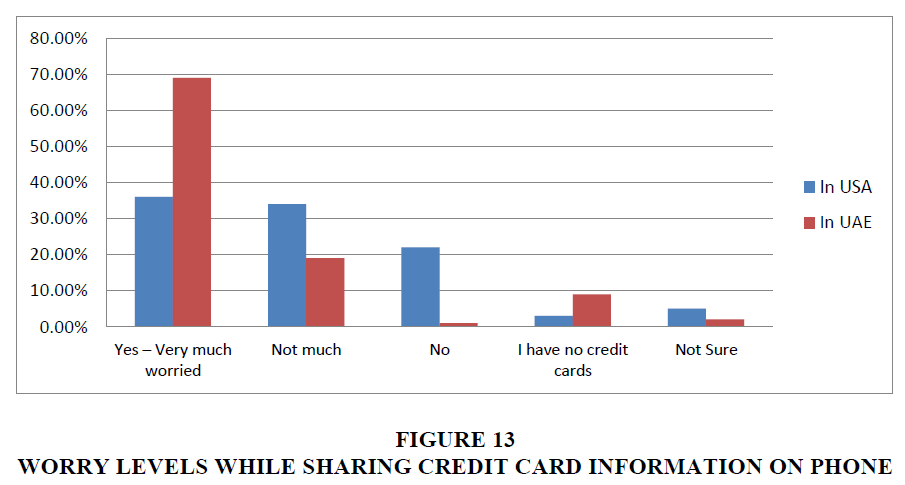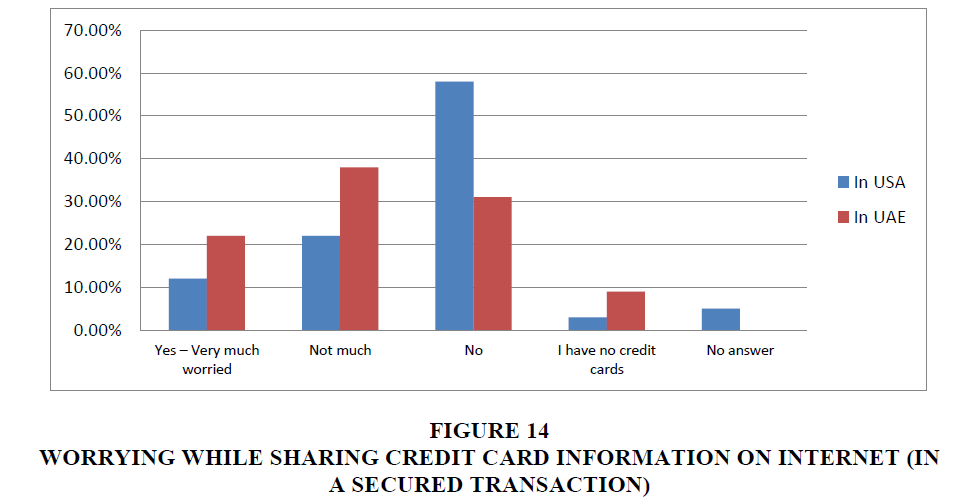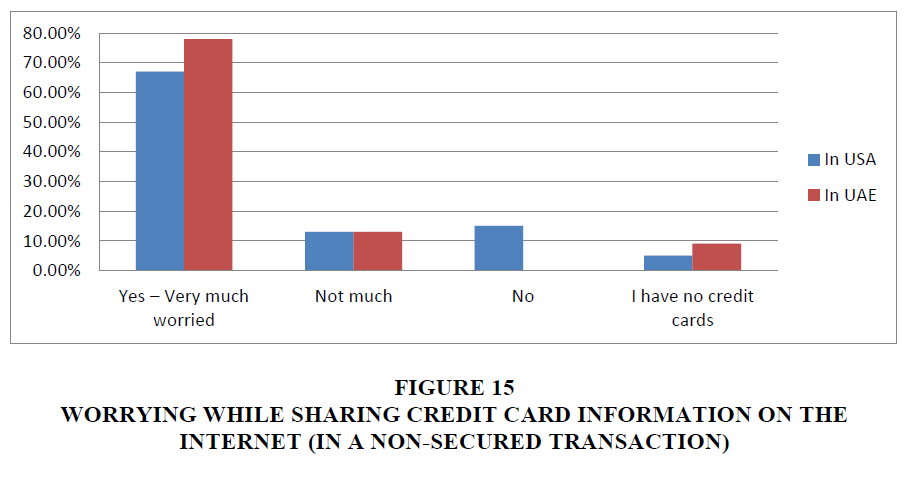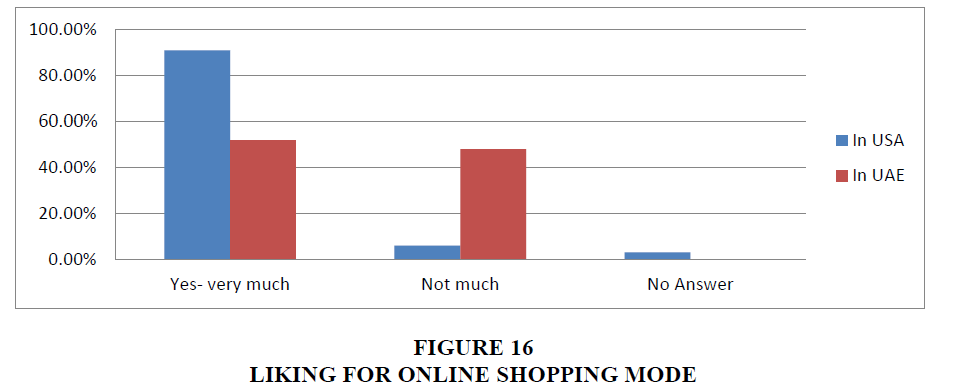Research Article: 2019 Vol: 23 Issue: 1
Online Shopping Behavior in West And East: A Comparative Analysis of USA and UAE Shoppers
Abstract
It is seen that online shopping has already been accepted at large in many developed countries but it is at its infancy in many developing countries. Although there is an overall growth in online mode of shopping worldwide but its acceptance and usage varies by region to region or by nation to nation. It is found that people have begun switching to online mode of shopping at a higher pace in developed countries as compared to developing countries where most of consumers still prefer to shop from the physical stores/shopping malls. When online shopping is progressing in a developed country like United States of America (USA), then why it is not progressing in the same way in a developing country like United Arab Emirates (UAE). Keeping this purpose in mind this study attempts to first examine the shopping behaviors of USA and UAE shoppers specifically towards online shopping mode and then tries to investigate the reasons which are responsible for the difference in shopping behaviors of shoppers in west and east i.e., shoppers in both the countries-U.S.A. and U.A.E.
Keywords
Brick and Mortar, Brick and Click, Web-Marketing, United Arab Emirates, Shopper Behaviour, UAE, USA, Online-shopping.
Introduction
With the invent of new technology of internet, consumer’s buying behaviour has changed dramatically and new shopping habits have evolved gradually during the last one decade or more. Lubis (2018), states that due to stable and faster presence of internet, human behavior has changed dramatically at a much rapid rate. Distance becoming meaningless day-by-day. Communications and trading happens much faster thru internet that too without any significant pauses. This new medium of trading “business-to-consumer electronic commerce (e-commerce)” has captivated the attention of retail marketers.
These days online shopping mode is becoming more popular because of convenience and comfort shoppers get in sitting at home and experiencing good shopping. Shanthi & Kannaiah (2015) feels that although many shoppers are moving towards webstores, but still at large consumers prefer to shop directly from the physical stores. Further they stated that theoretically it may sound good that people have begun to shift to online shopping. Nevertheless, a large number of shoppers practically still survive by using traditional ways of shopping due to their varied reasons at certain times for certain type of products. Lubis (2018) says by introducing online shopping apps, these days many tradional retail stores are turning into online webstores. Due to presence of online shopping mode in addition to traditional physical shops, buyer shopping behavior is greatly influenced and changed. Today, the conventional retailers are questioning whether their traditional brick-and-mortor model (traditional physical shpos) will continue to be successful or to meet the new challanges they should adapt to brick-and-click model (online webstores) i.e. adding the e-tailing mode to their conventional physical retail stores (Saxena et al., 2018).
Barutcu (2010) says that business and marketing activities have been influenced by internet technology and this revolutionary development and use of internet has modified the functioning of marketing, retailing, advertising, commerce and shopping of goods and services. Use of internet facilitates e-shoppers to have quick and easy access to information about products and services; vertical information i.e. facilitates buyers to compare competitor’s products and information quickly at low cost to efficiently screen the competitive offerings and locate a low price for a specific product and service (Kolesar & Galbraith, 2000). Barutcu (2010) stated, even an increasing number of e-customers are turning to the internet to make their purchases, many e-stores are going out of business. An e-shopper can very easily switch to another e-retailer because of not getting satisfactory e-service quality, high price of products or e-store design etc. Moreover, there is no switching cost from one e-tailer to another one. Therefore, one of the main issues in e-marketing is related to e-customer satisfaction level provided during e-shopping.
Kim & Eam (2002) stated that on the one hand, improving e-shopper’s satisfaction level has a greater chance of repurchasing from the same e-retailer and remaining a loyal e-customer of e-shopping mode. On the other hand, if an e-shopper is dis-satisfied is likely to move from e-stores to traditional shopping store and most likely will spread negative word-of-mouth for e-shopping mode. Thus, e-shoppers who are not fully satisfied thru e-shopping mode might not shop a product or service from e-stores if they have an option of buying somewhere else. Faqih (2013) says that due to comfort and a better experience people prefer online buying. Also this mode is becoming more and more popular because of steady stream of new online buyers and emergence of new product categories sales on online mode. E-commerce statistics confirm the explosive pace at which this industry has developed as worldwide B2C e-commerce sales amounted to more than 1.2 trillion US dollars in 2013 (Saxena et al., 2018). Shanthi & Kannaiah, (2015) stated that although these days many of the buyers do lot of internet surfing to find the best solution to their present and future needs and move towards the webstores of their choice, but still majority of the consumers go straight away to traditional shops to do shopping in the most traditional forms. Saxena et al. (2018) found in their latest study performed on shoppers in U.A.E. that “in general there is a positive attitude of shoppers for online shopping in UAE, but the future of e-tailing success in the U.A.E depends on identified seven key factors competitive price, variety of products, user friendliness of the website, adapting multiple security measures, offering multiple payment methods and finally having a professional appearance”.
Faqih (2013) feels that web marketing has already been established in developed countries, which is yet to establish in developing countries. Since online shopping trend is at its emerging phase in developing countries, many of the researchers are finding this area more and more interesting to explore further. Lot of research has been done on shopper’s buying behavior with special focus on online shopping motives and causes of dis-satisfaction and attrition in developed countries; but such studies are very limited in developing countries. This study is an attempt to fill this gap, which first tries to understand in general the shopper’s behavior and attitude in developed (USA) and developing countries (UAE) and then attempts to identify the motivating factors and reluctance factors of shoppers towards online shopping mode in both the countries (USA vs. UAE i.e. West vs. East).
Literature Survey
With the emergence of many new shopping forms, consumers nowadays consider multiple buying options before making a purchase. Based on type of need and the product type, shoppers choose the most suitable mode from available shopping optios viz. the physical stores, through catalogs, through teleshopping or online stores. According to Palmer (2000) “How to shop?” and “where to shop from?” are the basic questions to be answered by oneself every time they think of purchasing a certain product. This is a debate not only faced by shoppers but retailers have to decide on which format(s) to offer to their customers as well (Palmer, 2000). According to Tino & O’Cass (2001), an important dimension to understand retail behavior is “consumer attitudes”. Those who adopt the non-store shopping are those consumers who show a positive attitude towards the non-store environment. According to Tauber (1972), other contributors are “social and personal motives”; where social motives are wanting to meet with friends, peer group influence, status and bargaining. Whereas the personal motives are role-playing, entertainment, self-satisfaction, physical activity and sensory stimuli.
According to Bellenger & Korgaonkar (1980), there are two types of consumers; those of who are recreational consumers, consumer who enjoy shopping and treat it as a leisure activity and those who are economic, consumers who do not favor the shopping experience or are neutral. Another dimension to take into consideration is “price sensitivity” and here again a debate lies between experts, as some think that people who are price-sensitive are mostly attracted to non-store shopping, while other experts and researchers state that price is the least factor that contributes in an online purchase (Fenech & O’Cass, 2001). The major factor that has been identified to affect online retailing is “convenience” of the shopper. Shoppers feel that online shopping is convenient; Darian (1987), has identified 5 dimensions of online shopping-convenience, time saving, time flexibility, reducing stress and increasing impulse buying due to online advertisement while surfing the web.
The price of products and services are majorly influenced by the incurred fixed and variable costs and the demand curve. The popular law of demand says that in most of the cases price is inversaly proportionate to the quantity purchased i.e. low price creates more demand and price increase leads to reduction in demand excepting a few specific categories of products and services and services and unique buying situations. According to Phan & Vogel (2010) when the price of a product or service is kept high, only a few shoppers come forward to buy; and when the price is kept lesser, more and more shoppers rush to buy. Retailers by using appropriate price discrimination can maximize their profitability. It is quite evident thru the iterature survey that by having a mix of brick and click model i.e. by having both physical shops and web shops retailers explore the opportunity of using price discrimination approch to maximize their profits. Since the fixed costs in a web shop is much lesser than the physical shop, retailer using both these modes can charge lesser price on their web stores to lure the shoppers to buy online.
Guo & Luo (2017) in their research paper titled as “The effect of sales and evidence from micro data” investigated the effect of sales through a novel product level data set. Resuls of their study stats that consumers are more price sensitive when the products and services are offered on sale compared to when there is no sale. Also they found through their study that shoppers are more aware of price decreases than the price increases i.e. magnitude of price decreases is much higher than the magnitude of price decreases. Shoppers feel they are not purchasing at a high price when they buy online or the products offered with a sign of “sale” or “save more”. Further this eliminates the possibility of consumer’s regret and thus results in increased consumtion and greater preference for online shopping mode as it offers them a price advantage (Guo & Luo, 2017). Retailers practicing brick-and-click model generally use discremenatory pricing and influencing online customer’s behavior by communicating them a high value oriented pricing.
Store atmosphere is also affecting the shopper’s behavior in online shopping, but in a virtual form. According to the Virtual Component Presentation Framework (VCPF) the online environment consists of three factors: 1) layout and design of web site; 2) web site atmospherics; and 3) theatrics (Manganari et al., 2009). With regards to the virtual layout and design, consumers prefer the freeform layout in finding their shopping list products. Even though the grid layout is easier than the freeform and the racetrack layout, the freeform stays to be the most entertaining (Vrechopoulos et al., 2004). As for the virtual atmospherics, color is the main factor to be studied which affects the consumer’s response. Cool colors lead consumers to perceive the download time quicker (Gorn et al., 2004). According to Biers & Richards (2005), when expensive items are shown on cool background colors, the likelihood of purchase increases. In regards to the virtual theatrics, retailers try to use images and animation on their websites. According to Martin et al., 2005, medium complex websites are favored more than low or high complex websites by consumers. Barutcu (2010) analyzed and tested e-customer satisfaction in Turkey by using six drivers of e-customer satisfaction: e-shopping cost, e-store design, e-customer service, information quality, shipping policy and cargo carriers service quality; and according to survey results, apart from existing e-store shipping policy, all drivers influence e-customer satisfaction positively. Reliability, customer service, privacy and security are identified as the most common dimensions of e-retailer’s website design. Shoppers will always tend to visit user friendly web stores and in contrast, if they feel that the e-store’s website is difficult to use and to follow, they will show a lower intention to purchase in online (Thamizhvanan & Xavier, 2013).
Study by Rose et al. (2012), stated that experience is the strongest generator of self-efficacy and thus generating positive experience has acquired greater prominence due to its potentiality in influencing customer loyalty. A large number of empirical studies have highlighted “perceived risk associated with online shopping” has maximum negative influence on web based shopping (Mukherjee et al., 2007; Faqih, 2013; Saxena et al., 2018). Faqih (2013) says that perceived risk also has the characteristics of shopper’s hidden eagerness to participate in online shopping as it is perceived to increase vulnerabilities of web based shopping, the non-traditional mode. Shoppers carry a low perception and less trust on online merchants, which makes them unwilling to buy thru online mode. The perception of risk associated with company and their web stores can also be influenced by shopper’s previous encounters; affecting their decisions to complete purchase without sensory perceptions available in traditional brick-and-mortar stores (Shinde & Sharma, 2016).
In the nonexistence of personal and physical interaction, trust and commitment are two issues that are vital in the online-retailing. Consumers are mostly concerned about the hack of credit card information and personal information resulting in identity theft. Retailers not only have to make their web stores appealing to the online shoppers but also have to develop a trustworthy relationship with them in order to increase sales and develop customer loyalty. According to Avinandan & Nath (2007), in online mode of shopping the buyer and seller are not at the same place and are physically separated, their relationships are very complicated and difficult to monitor and in the online mode cyber-laws are not clearly defined, which demands a strong feeling of trust in the shopper’s mind to reduce the perceived risk in web based shopping. Confidence is another aspect of trust in which it is related to the retailer’s reputation, brand name and third party experiences and recommendations. Trust in technology is also an important factor which varies according to the customer’s trust in technology itself, whereby it affects their trust in engaging in a purchase using technology. According to Mukherjee & Nath (2007), privacy is the number one determinant of consumer trust and retailers are expected to have a clear privacy policy stated on their website promising not to share consumer’s personal information without their consent. This leaves security to be the number two determinant of consumer trust where consumers look for authentication seals where retailers are expected to use the latest security features to be more trustworthy.
The slow catching on of online-retailing in the UAE has been due to the climate of the country that drives people to visit malls for social reasons and not necessarily for shopping. According to the Telecommunications Regulatory Authority, UAE had 1.47 million internet subscribers (68.5% of residents) at the end of May, 2010. One-third of those 1.47 million say they never bought anything online. Of those who are using online retailing in the UAE, according to a research from Neilsen, are mainly using it for airline tickets, hotel reservations and purchasing books (Ligaya, 2010). Saxena et al. (2018) stated in their study that in general people in UAE have experienced online shopping mode at least once either by shopping thru a global retail store or a local retail store; but around 21% of shoppers in UAE have never done shopping thru online mode. Their study states that shoppers in UAE go online mainly because of convenience (36.0%), wider variety (25.0%) and lower prices (23.0%). Further they stated the main hesitation reasons/UAE shopper’s concern in online shopping as shipping costs (33.0%), examine product physically (29.0%) and security measures (28.0%). Most of the researchers and practitioners associate “the trust factor” behind the success or failure of online mode of retailing. Many researchers say there is not much difference in traditional and online buying behavior; but quite often it is argued that one more step has been added in online shopping mode-the step of building trust and wining shopper’s confidence (Prasad & Aryasri, 2009).
According to Nwaizugbo & Ifeanyichukwu (2016), past experience has a significant relationship with online shopping. Consumers who continue shopping online have tried it once and enjoyed the process entirely. Thus they continue. E-stores should make shopper’s buying experience worthwhile for the online shoppers to ensure repeat e-purchase. Therefore, e-retailers should seek new ways of delivering superior value to online shoppers so that they become their loyal e-shoppers. Online shopping offers time economy and cost advantage to the consumers. The discount and offers, home delivery facility, availability of vide assortments of products in single window attract the shoppers (Pandey et al., 2015). Punj (2011) in his study highlighted the advantages of convenience, saving time cost and finding best solution to buyer’s needs thru online mode over the traditional way of shopping. By using suitable apps ensuring the safety features, e-retailers can enhance safety and securities to minimize the risks that may occur in online shopping mode. Lubis (2018) found in his study that even online shopping has risks, still 61.0% of participants (in a sample of 200) preferred online shopping over the traditional mode of shopping. Charumathi & Rani (2017) find in their study that major risk involved in online shopping is the difficulty in judging the quality of product thru internet and the level of difficulty that may involve in availing after sale service if they shop online. The other major perceived risk in their findings is the risk associated with credit card information which they are asked to share online with the e-retailers. The other risks are convenience risk because of anxiety till the product arrives and non-delivery risk and non-availability of reliable & well equipped shipper.
Clemons et al. (2016), in their study compared trust in online shopping in four countries: (1) United States, (2) Germany, (3) China and (4) Singapore. They stated in their findings that in United States, online shopping is treated as just another form of shopping. The online market appears similar to the offline market. In the United States of America online buying is just like one more option of shopping available to shoppers and people choose the best way to shop as per their specific buying situations. They stated Germany as a representative of a large portion of e-commerce in the European Union and much of the developed world. Their results in Germany and China suggest that shoppers need assurances/guarantee for the safety and security, their level of trust varies between more experienced markets and markets with less experience. According to them the operations of the top Chinese shopping websites, such as Yihaodian and 360 buy are so much superior and they enjoy much stronger reputations of their web stores than the traditional physical stores. This unique behavior of Chinese online shoppers at their most trusted websites is somewhat same with German online shoppers. Further they stated that since Singapore has a well-developed legal system, therefore shoppers here might perceive that there is a little opportunity for a seller to escape if they make false claims about product quality and cheating in financial forms, hence less risk and comparatively more trust in online shopping mode. They found that reputation matters. The effects of promises and third-party assurance were more complex and differences in the level of trust and online shopping behavior among the different countries were indeed significant.
Methodology
Exploratory research design is used to study the behaviour of shoppers in west (USA) and east (UAE) towards online mode of shopping. In this study primary data is collected by executing a structured and non-disguised questionnaire among 100 shoppers in USA and equally 100 shoppers in UAE. Designed questionnaire was executed in Pittsburg, Seattle, Houston and Chicago cities in USA thru personal and e-mail mode with the support of author’s daughter Gaurangi who is settled in USA. The same questionnaire was executed in Dubai, Abu Dhabi, Sharjah and Ajman in UAE by author himself with the support of son-in-law Sumit and daughter Shivangi thru online survey mode by using their contacts on social networking websites such as facebook, e-mails and other personal forums, as law doesn’t permit face-to-face (personal surveys) in U.A.E. In total a sample of 200 shoppers (100 from each country) was found appropriate as most statisticians approve a minimum sample size of 100 in getting any kind of meaningful result in an exploratory study. Author framed fifteen straight, to-the-point and simple questions in the survey questionnaire executed in USA and UAE to assess the shopper’s behaviour towards online mode of shopping and to further investigate the difference in their behaviours, the collected data was tabulated and analysed by calculating simple percentages in each category given under each question. Key findings of the study are depicted in tabular and graphical (pie chart) forms to clearly understand in general the behaviour of shoppers in each country and specifically looking at the similarities and differences in both the selected countries. (i.e USA and UAE) in a simple comarable form. At the end study is concluded with its major results and suggestions to e-retailers for winning trust and confidence of e-shoppers to attract more and more customers towards e-shopping mode and book more and more sales and profits in the highly dynamic and competitive global retail markets.
Results And Discussion
For assessing the general behaviour of shoppers towards online shopping mode in USA and UAE, a very basic question was asked to respondents to check whether they have ever done online shopping; and findings state that in USA 75% of the respondents have experienced online shopping whereas in UAE only 39% of respondents have done shopping online (Table 1). This clearly indicates that 61% of UAE shoppers have not yet experienced the online shopping mode as compared to 25% in USA. This vast gap between the behavior of shoppers in west and in the east creates a very natural curosity to investgate further to know the reasons of this difference in the behaviour of USA and UAE shoppers (Figure 1).
| Table 1: Online Shoppping Experience | ||
| Have done online shopping | In USA (100) |
In UAE (100) |
|---|---|---|
| Yes | 75.0% | 39.0% |
| No | 25.0% | 61.0% |
Above findings can be compaired with the findings of the earlier studies done on the subject. The study titled as “Global Trends in Online Shopping” conducted by Lorena (2018) stated that in the Middle East, Africa and Pakistan almost half (47%) of the consumers have never shopped online; whereas half (50%) of the North Americans shopped very frequently from online stores. To guage the growth in online shopping and to understand the internet buying behavior of shoppers a survey was done by Stevens (2016) which shows shoppers in the United States were doing more than 50% of their shopping on the internet as compared to 47% in 2014 and 48% in 2015, regestering increase year-by-year.
When in this study participants were asked to answer the question that how many times they have made online purchases, the findings are quite similar to the above findings by Stevens (2016) and Lorena (2018). Results show that in USA 20.0% of the respondents have bought online more than fifteen times, 13.0% stated that they have purchased 7 to 15 times, 13.0% stated 4 to 6 times , 20% 2-3 times, 9.0% have purchased only once and 25.0% have never purchased online, as compaed to 5.0% , 2.0%, 6.0%, 22.0%, 4.0% and 61.0% respectively in UAE (Table 2). Considering this overview in both the countries, it is clearly visible from the findings that in USA people have been using online shopping mode more frequently as compared to shoppers in UAE (Figure 2).
| Table 2: Usage Of Online Purchase Mode | ||
| How many times have done online shopping | In USA (100) | In UAE (100) |
|---|---|---|
| Never | 25.0% | 61.0% |
| Once | 9.0% | 4.0% |
| 2-3 times | 20.0% | 22.0% |
| 4-6 times | 13.0% | 6.0% |
| 7-15 times | 13.0% | 2.0% |
| More than 15 times | 20.0% | 5.0% |
Above observation further raises the curosity to investigate why people have not yet experienced online shopping (61.0% in UAE and 25.0% in USA) and to know the primary reason behind online purchase from those shoppers who have purchased online i.e. 39.0% in UAE and 75.0% in USA. Findings of the study reflect that mojor reason for non-buying thru online mode is the unwillingness of the people (28.0% in USA (Figure 3) and 55.7% in UAE (Figure 4) in sharing their personal billing information/credit card details over the internet. This reflects their serious concern about the safety and security of their personal financial details and have fear in sharing those details with the sellers while shopping online. Some other resons of non-buying thru online mode are unfamiliarity with the company (12.0% in USA and 9.8% in UAE) and difficulty in finding the right product thru online mode (16.0% in USA and 1.6% in UAE) (Table 3). These findings match with the views given by Lorena (2018), stating privacy and security as the most legitimate concern for any online shopper, especially when they are asked to pay online. What to do when seller or vendor himself is a fraudulent, accepting shoppers’ payments and later either refuse to send your item or send you the wrong or defective item? Therefore these days vast majority of online buyers are seen more comfortable with the option of cash on delivery after the correct and safe arrival of their ordered products (Lorena, 2018). According to Katawetawaraks & Wang (2011), “online trust is one of the most critical factors that affects the success of online retailers”. Customer are more confident and comfortable while buying from an online retaler who they have found reliable and trustworthy due to strong security and privacy measures taken by them which had resulted in a positive e-shopping experience in the past. It has been deduced from the literature survey that risk and trust are the two most important and most crucial factors impacting the intention of shopping online (Saxena & Das Gupta, 2018).
| Table 3: Main Reason For Not Buying Online | ||
| Main reason for not buying online | In USA (25) | In UAE (61) |
|---|---|---|
| No Answer | 20.0% | 6.6% |
| Don’t like sharing personal information online | 28.0% | 55.7% |
| I don't do much shopping online | 16.0% | 22.9% |
| I am unfamiliar with the company | 12.0% | 9.8% |
| I could not trace the item, I was looking for | 16.0% | 1.6% |
| I'm not sure of safety of order if not given to person | 8.0% | 3.3% |
Further while exploring the main reason for buying online, especifically the respondents who have experienced online shopping at least once (i.e. 75% and 39% of respondents in USA and UAE respectively), it is found in the study that main attraction for shoppers to buy online is the price advantage (41.3% in USA and 35.9% in UAE). Convenience too is the another reason behind buying online for 28.2% shoppers in UAE as compared to 25.3% in USA. 17.9% of UAE shoppers state that they could find desired item nuch easily thru internet as compared to other shopping modes (Table 4). This same reason behind online shopping is stated by 10.6% shoppers in USA. A few other main reasons for buying online are quality of website (7.6% and 4.0% in UAE and USA respectively) and unique nature of item (6.6% in USA and 5.1% in UAE) (Figure 5). According to Saxena & Das Gupta (2018), online shopping has emerged as a more preferable option of shopping because of being more comfortable as compared to shopping in physical stores in malls as it is making shoppers free from many challenges such as traffic jams, struggling for getting parking, limited time and many more hassels. According to them the major factors having impact on online shopping and which act as motivators or deterrents in online buying are: (1) internet/computer knowledge, (2) product Characteristics, (3) online product reviews, (4) convenience, (5) website design, (6) return/exchange, (7) security and privacy measures, (8) prior experience, (9) online price promotions and (10) branded merchandise offered by online retailer. These factors were identifed after performing an exhaustive review of empirical studies conducted on online shopping behaviours of consumers globally (Saxena & Das Gupta 2018). Intensity of each of these factors may vary from country-to-country and from time-to-time, which clearly can be seen in the following findings of this study.
| Table 4: Primary Reason For Buying Online | ||
| Main reason for online shopping | In USA (75) | In UAE (39) |
|---|---|---|
| The Price | 41.3% | 35.9% |
| The Convenience | 25.3% | 28.2% |
| The Explaination of the item and its features | 9.3% | 2.6% |
| The Ease of finiding the specific item | 10.6% | 17.9% |
| The Unique Nature of the Item | 6.6% | 5.1% |
| The General Quality of the Website | 4.0% | 7.6% |
| The Payment Method Options | 2.7% | 2.6% |
Further among the people who have already experienced online shopping (i.e 75.0% in USA and 39.0% in UAE) an attempt was put to assess their buying pattern in general i.e. whether they go usually for online shopping or in genaral they buy from traditional physical shops/malls. In USA 35.0% of respondents stated that they prefer to buy from standalone webstores as compared to 12.0% in UAE. It is also noticed that although people have experienced online shopping at webstores but still in genearal their first preference is physical shops/malls (26.0% and 22.0% in USA and UAE respectively) (Table 5). As 25.0% of respondents in USA and 61.0% in UAE have not yet tried online mode of shopping; and therefore if we assess the same responses among the experienced online shoppers (75.0% in USA and 39.0% in UAE), we find that 46.6% in USA and 30.7% in UAE in general go for online shopping mode, whereas 34.7% in USA and 56.4% in UAE genarally buy from physical shops/malls although they have experienced online shopping at least once and more. From these observations we feel that in UAE still people have more inclination to buy from tradional physical shops/malls as compared to online shopping mode, as compared to USA where shopper’s preferences are comparatively more for online shopping (Figure 6). As stated by Clemons et al. (2016) in the mature online markets such as United States, online shopping mode is now treated as just another option of buying to meet your needs, whereas in developing countries online mode is picking up slowly-slowly as it might take little time to develop confidence and comfort level with this emerging mode depending upon security and trust factors; and associated perceived risks (Clemons et al., 2016).
| Table 5: General Purchase Pattern (Website/Physical Shop) | ||
| Generally Purchase from | In USA | In UAE |
|---|---|---|
| Standalone Website | 35.0% | 12.0% |
| Mall/Physical Shop | 26.0% | 22.0% |
| Not sure | 11.0% | 5.0% |
| N/A-Never purchased anything online | 25.0% | 61% |
| No Answer | 3.0% | 0.0% |
When shoppers were asked to give their opinion about whether they will again repeat their purchase from their patronized webstores, 55.0% in USA and 37.0% in UAE said “Yes”, while 16.0% in USA and 2.0% in UAE answered “Not Sure”. Since 25.0% and 61.0% of respondents from USA and UAE respectively have never purchased online, this proportion of repeat buying from patronized webstores among the online shoppers (75.0% and 39.0% in USA and UAE respectively) is found much more higher (Table 6). Findings reflect that 94.9% of UAE online shoppers and 73.3% of USA online shoppers will again do repeat buying from their patronized stores while remaining online shoppers said may be. Only 4.0% of USA online shoppers said “No” that they will not rebuy from same webstore, whereas this was nil in case of UAE web shoppers. These results clearly indicate that all those respondents who have done online shopping once or more are further interested in buying online from their patronised webstores (Figure 7). According to Clemons et al. (2016), “The online behavior of U.S. shoppers seems similar to their offline behaviour”. Further they explored in their study that consumers are simply more comfortable dealing with a trusted seller. They stated in commerce terminology in their paper about making an investment in creating and maintaing “the reputational capital” reducing a firm’s opportunistic behaviour and creating the firm’s reputation in the long run; ultimately resulting in building consumers trust and confidence in the firms those enjoy strong reputation, where buyers belive that the selling organisation is honest and concerned about its customers (Clemons et al., 2016). This reputation factor plays a very strong role in online buying and is quite evident in the below given findigs.
| Table 6: Opinion About Repeat Purchase From The Patronized Website | ||
| Repeat purchase from petronized website | In USA | In UAE |
|---|---|---|
| Yes | 55.0% | 37.0% |
| N/A-Never purchased anything online | 25.0% | 61.0% |
| Not Sure | 16.0% | 2.0% |
| No | 4.0% | 0.0% |
When respondents were asked about their payment method used in online shopping, majority of the respondents mentioned that they paid thru credit card via secure method (55.0% in USA and 30.0% in UAE); which is found 76.9% and 73.3% respectively among the 39.0% and 75.0% online shoppers in UAE and USA. Respondents using other payment modes/options were quite limited/less in number i.e. payments made thru credit cards but not secure mode were 8.0% in USA and 6.0% in UAE from all the respondents, which comes to 10.6% and 15.4% respectively among the online shoppers in USA and UAE (Table 7). These findings imply that people prefer buying online using credit cards if it is thru secure mode as compared to any other payment option given for online shopping to them (Figure 8). According to McCrohan (2003), security is the most dominating issue for online shoppers. Both customers and the retailers have the same question, whether online monetary transactions are safe, fearing always from the cyber-criminals. A good online store must include third party security on its site, which helps in enhancing customers’ confidence and building positive attitude towards online buying.
| Table 7: Payment Mode For Online Shopping | ||
| Payment method used for Online shopping | In USA | In UAE |
|---|---|---|
| Secured method for using Credit Card | 55.0% | 30.0% |
| Never purchased anything online | 25.0% | 61.0% |
| Using credit card but not sure of security | 8.0% | 6.0% |
| Provided credit card info over given phone number | 3.0% | 0.0% |
| Sent check/money order via postage/courier services | 4.0% | 1.0% |
| Not Answered | 5.0% | 2.0% |
As per the research studies conducted within the United States, approximately two-thirds of Americans doubt the safety measures and feel even if retailers assure safety measures those are still not sufficient in protecting against online theft (McCrohan, 2003). It is found where retailers have succeeded in maintaining strong security and privacy measures, shoppers’ interest towards online shopping increases and instills trust in consumers’ minds (Katawetawaraks & Wang, 2011). Despite the fact that shoppers have high concern for privacy and security measures while shopping online, we can see from various studies that online shopping is steadily rising (Lorena, 2018).
Although main reason for respondents not buying online was their worry in sharing their billing information/credit card information online as discussed above and shown in Table 3, Figures 3 and 4 but when explored further it was found in the study that majority of the shoppers have not experienced any misuse of their credit cards. In a few cases some issues were faced but were resolved without any loss/liability (Table 8). Results in USA and UAE are almost similar and majority of respondents have not faced any issues with the use of credit cards while buying online (Figure 9).
| Table 8: Misuse Of Credit Card Without Approval | ||
| Misuse of your credit card without approval | In USA | In UAE |
| No | 76.0% | 73.0% |
| I don’t have any credit cards | 3.0% | 9.0% |
| Yes-but I cleared it up without any liability | 8.0% | 4.0% |
| Yes-by a family member | 1.0% | 2.0% |
| Yes-I ended up having to pay | 1.0% | 2.0% |
| No answer | 11.0% | 10.0% |
The Nielsen company in March’ 2010 conducted a survey of over 27,000 internet users in 55 markets from Asia Pacific, Europe, Middle East, North America and South America to study the online shoppers’ behaviour and as per the results of their study, there are some products purchased online that are universal, and others are yet to fetch a significant share of online trade (Lorena, 2018). According to Saxena & Das Gupta (2018), different product types influence shoppers’ acceptance of online buying. There are certain “high-touch” products, where shoppers need to touch, feel, smell and try the product before buying, and therefore will not buy them online. Sometimes for certain ‘high-tech’ products shoppers want to physically evaluate them in the shop and need more information or a proper demonstration before making the final purchase decision, such products are also not preferred to be shopped online. Perotti et al. (2005) stated in their study that similar to traditional physical shops shoppers, online shoppers also fall within two categories. One who shop online for enjoyment or entertainment are “hedonic shoppers” and the other ones who shop online for specific reason or purpose they are the “goal-oriented shoppers”. In this study, when respondents were asked to mention the products and services majorly purchased by them thru online mode, they mentioned a number of products and services therefore sum total of percentages of those options are more than 100. After thorough analysis of all the given options in USA majorly people have purchased books and magazines (43.9%), clothing/apparels (31.9%), computer related products and services (29.8%), music and videos (25.9%), gifts (23.0%), travel and vacations (22.6%) and many more items as shown in the Table 9. The shopper’s preferences for online shopping in UAE demonstrate substantial differences with USA shopper’s preferences. In UAE majorly of the respondents have used online shopping mode for travel and vacations (40.4%), clothing/apparels (38.2%), food/drnik (22.1%), gifts (7.1%) and many more as shown in the Table 9. When we compare the shopping patterns in both the countries, we find that in UAE people usually use online shopping mode for services such as travel and vacations, ordering food and drinks etc; and among phusical products mainly they order clothings/apparels and gift items of their choice online. Whereas in USA shoppers buy a variety of products and services thru online mode as shown in Table 9 and Figure 10.
| Table 9: Products Majorly Purchased Thru Online Mode | ||
| Products majorly purchased online | In USA | In UAE |
|---|---|---|
| Books, Information and Magazines | 43.9% | 7.1% |
| Clothing | 31.9% | 38.2% |
| Computer-related products & services | 29.8% | 4.2% |
| Music and Videos | 25.9% | 0.0% |
| Gifts | 23.0% | 7.1% |
| Travel and Vacations | 22.6% | 40.4% |
| Electrical & Electronic Items | 17.8% | 2.1% |
| Games,Toys & Kids Playing Items | 13.4% | 2.1% |
| Plants and Flowers` | 11.7% | 0.0% |
| College Services | 10.8% | 0.0% |
| Sports and Fitness Items | 10.6% | 0.0% |
| Internet Products and services | 10.3% | 2.1% |
| Cosmetics and Beauty Aids | 8.9% | 0.0% |
| Jewelry and Accessories | 8.0% | 6.3% |
| Home Products | 9.9% | 0.0% |
| Food/Drink | 6.3% | 22.1% |
| Medical and Health Products | 4.2% | 2.1% |
Alam & Yasin (2010), in their study identified website design, reliability, product variety and delivery performances as the four key determinents of consumers’ satisfaction of online shopping. Lee (2005) stated two types of online shopping values; first as utilitarian value which includes time savings, price savings, service excellence and selection dimensions and second as experiential value which includes entertainment, visual, escape, and interaction dimensions. When respondents were asked to state their satisfaction level with the products purchased online, majority of the shoppers were found highly satisfied. In USA 53.0% of total respondents (i.e. 70.7% of online shoppers) and in UAE 24.0% of total respondents (i.e. 61.5% of online shoppers) were “highly satisfied”; while remaining stated “somewhat satisfied” (Table 10). These findings clearly indicate that in general people have no specific negative feeling with the online shopping mode as in UAE no one stated that they are not satisfied corresponding to just 1.0% not satisfied in USA. Majority of the online shoppers in both the countries are either very satisfied or somewhat satisfied, but they are not dis-satisfied. Although in UAE online shoppers are less (39.0%) than USA (75.0%), but their online shopping experience is same positive as in USA (Figure 11).
| Table 10: Satisfaction Level Of Shoppers Made Online Purchases | ||
| Satisfcaction with the products purchased online | In USA | In UAE |
|---|---|---|
| Very satisfied-no problems | 53.0% | 24.0% |
| Somewhat satisfied | 18.0% | 15.0% |
| N/A-Never purchased anything online | 25.0% | 61.0% |
| No Answer | 3.0% | 0.0% |
| Not satisfied-many problems | 1.0% | 0.0% |
When shoppers were asked to give their opinion for online shopping mode and mail ordering mode, majority of the shoppers found online shopping more appealing. In USA 58.0% of total respondents (77.3% among online shoppers) and in UAE 24.0% of total respondents (61.5% among online shoppers) preferred online shopping mode over mail ordering mode; whereas 12 to 13% in both the countries were of the opinion that online shopping and mail ordering are same (Table 11). Based on these observations it can be implied that majority of the respondents in general found online shopping mode more appealing as compared to mail ordering mode (Figure 12). Joseph & Leo (1998) performed empirical investigation of perceptions of internet shopping and more traditional mail catalog shopping. Results reflect significant differences in individuals’ perceptions of internet shopping and mail catalog shopping. They stated further that these perceptions differ due to individual differences in personality.
| Table 11: Shopper’s Opinion For Online Shopping And Mail Ordering | ||
| Compare online shopping with mail ordering | In USA | In UAE |
|---|---|---|
| Online ordering is more appealing | 58.0% | 24.0% |
| They're both about the same | 12.0% | 13.0% |
| N/A-Never purchased anything online | 25.0% | 61.0% |
| Not Sure | 4.0% | 2.0% |
| Mail-order is more appealing | 1.0% | 0.0% |
According to Hoffman (1999), “In the physical world, a buyer might not be comfortable in giving out credit card information over the telephone to an unknown voice while placing order to a company. Similarly while buying online, shoppers might fear in typing in the credit card information to a web retailer”. Further he stated that in the same way a commercial web provider may fear the efforts of a hacker intent on stealing credit card numbers. Unlike traditional retail shopping in the physical shops, where shoppers might feel that they have limited variety and choices in physical shops as compared to online web-stores but still they may be comfortable. Online shoppers’ perceptions concerning information privacy in the web based shopping may carry a striking negative influence on consumer willingness to engage in sensitive information exchanges online; and they might prefer telephonic mode over internet if to chose from these two options. Hernandez (2011), in his article reports the survey results conducted on 1,000 consumers in Great Britain by telecommunications technology provider Connected World. It is found that in Great Britain most shoppers are very much concerned about fraud with credit or debit card if shop over the phone. Results show that 71% of consumers were uncomfortable in sharing their card and personal information to a call-center operator while placing their orders. While 62% of the consumers expressed their worries about the scrutiny of their personal data when asked to share over the phone.
Similarily in this study, while assessing respondent’s worry levels in sharing credit card information over the phone for online purchase, majority of the respondents in UAE (69.0%) were very much worried as compared to 36.0% in USA. Findings show further that in UAE 19% of shoppers are not much worried and 1% not worried at all, corresponding to 34.0% not much worried and 22.0% had no worries in USA in sharing the credit card information over the phone (Table 12). These observations clearly indicate thet people in UAE in general are more worried if they are asked to share their credit card information over the phone as compared to USA where people are comparatively more confident and have less worries in sharing such information over the phone, means by large they have accepted this practice in USA as compared to UAE where people have shown serious concern over safety and security (Figure 13).
| Table 12: Worry Levels While Sharing Credit Card Information Over The Phone | ||
| Worrying while sharing credit card information on phone | In USA | In UAE |
|---|---|---|
| Yes-Very much worried | 36.0% | 69.0% |
| Not much | 34.0% | 19.0% |
| No | 22.0% | 1.0% |
| I have no credit cards | 3.0% | 9.0% |
| Not Sure | 5.0% | 2.0% |
Song et al. (2017) stated in their paper that security and privacy issues have been well investigated in typical vehicle ad hoc networks. They proposed an advanced online payment framework, which integrates three main features, including the free certificateless encryption, signature and semi-honest RSU-aided verification, and the CA-aided tracking and batch auditing, resulting in achieving a higher trust level and supporting primary security services. In this study, when respondents were asked to state their worry levels when they are asked to share their credit card information over the internet through secured mode. Findings show that 22.0% of shoppers in UAE and 12.0% in USA are very much worried after sharing their credit card information over the internet even though it is through secured mode. In USA 22.0% are not much worried and 58.0% are found not worried at all, as compared to 38.0% (not much worried) and 31.0% (not worried) in UAE (Figure 14). These findings clearly reflect that in USA either people are not worried or comparatively less worried in sharing their credit card information online thru secured mode corresponding to people in UAE, who are not comfortable in sharing credit card information online even if it is thru secured mode (Table 13).
| Table 13: Uncomfortable In Sharing Credit Card Information On Internet-Secured Transaction | ||
| Worrying while sharing credit card information on the internet (in a secured transaction) | In USA | In UAE |
|---|---|---|
| Yes-Very much worried | 12.0% | 22.0% |
| Not much | 22.0% | 38.0% |
| No | 58.0% | 31.0% |
| I have no credit cards | 3.0% | 9.0% |
| No answer | 5.0% | 0.0% |
According to Poll (2015) MMR a periodical from Los Angeles, “Online shoppers have little faith in the security of their credit card and personal information, even with the biggest online retailers and Internet technology providers”. As per the survey of over 6,200 shoppers by Bizrate Insights more than 76% of shoppers are dissatisfied with e-commerce protections. People across all generations and both genders, around 72% of shoppers trust their own bank most with credit card data and personally identifiable information. Aside from banks, the companies most trusted with payment and personal information are PayPal (48.9%) and Amazon (45.4%). When in this study respondents were asked to state their worry level while sharing their credit card information over internet through a non-secured mode, majority of them in both the countries were found highly worried. In UAE 78.0% were highly worried as compared to 67.0% in USA. 13.0% of the respondents in both the countries are found not much worried. In USA 15.0% of respondents had no worries even if it is through non-secure mode but in UAE no one stated that they have no worries in sharing credit card information on internet thru non-secure mode (Table 14). These findings reconfirm that people have serious concern for the safety and security measures if they are asked to share their credit card information online, their worry is much higher if they asked to share such information online thru non-secure mode. If we compare this worry level between the two countries, people are relatively less worried in USA as compared to UAE. Again a clear indication that people in UAE are less confident while shopping online and are more worried when they are asked to share their credit card information online and further much more worried if it is thru a non-secured mode (Figure 15).
Figure 15:Worrying While Sharing Credit Card Information On The Internet (In A Non-Secured Transaction).
| Table 14: Uncomfortable In Sharing Credit Card Information On Internet-In A Non-Secured Transaction | ||
| Worrying while sharing credit card information on the internet (in a non-secured transaction) | In USA | In UAE |
|---|---|---|
| Yes-Very much worried | 67.0% | 78.0% |
| Not much | 13.0% | 13.0% |
| No | 15.0% | 0.0% |
| I have no credit cards | 5.0% | 9.0% |
Survey results in the study done by Rahman et al. (2018) reveal that both males and females reflect similar behavior for liking and disliking the online shopping. Consumers shop online to save time, and for available varieties of products and services. In general they like home delivery facility and miss touch and feel factor most in online buying. Majority of the shoppers expressed serious concern about the security of the online payment system. Results relating to overall online shopping satisfaction level in the study showed little variations due to varying degree of motivating and deterent factors across product categories and need specifications but in genral they all were found quite open and positive towards online shopping.
Similarily when at the end of the survey in this study, last question was asked to the respondents to express their liking for online mode of shopping. Results show that in USA 91.0% of the respondents are positive for shopping online and just 6.0% were found not much interested in online mode of shopping, as compared to 52.0% positive and 48.0% not much interested in buying online in UAE. This clearly implies, as people in USA (75.0% of respondents) (Table 15) have already experienced online shopping and have had positive experience in online buying, therefore 91.0% of respondents expressed their liking for online shopping. But in UAE comparatively less people (39.0% of respondents) have experienced online shopping mode and even after having a positive experience majority is still buying from traditional shops/malls, hence only 52.0% showed their willingness to shop online and remaining 48.0% are happy to buy from non-online modes/traditional modes of shopping (Figure 16).
| Table 15: Liking For Online Shopping Mode | ||
| Like shopping online | In USA | In UAE |
|---|---|---|
| Yes-very much | 91.0% | 52.0% |
| Not much | 6.0% | 48.0% |
| No Answer | 3.0% | 0.0% |
The study conducted by Saxena et al. (2018) supports above results, which states that in general people in U.A.E. too have a positive attitude towards online shopping as in other developed nations, but future growth and whole-heartedly acceptance of e-tailing in U.A,E. deprnds upon how effectively and efficiently online retailers addresses the identified seven factors, which are offering competitive pricing, huge product variety, user friendlyness of websites, adapting multi-layer security measures for payment and information safety, offering range of payment options and building a professional, caring and trusted image by practicing all ethical, legal and social norms.
Conclusion
Based on the literature review and above findings of the surveys we may coclude, that online mode of shopping has been evolved and accepted at large in developed countries like U.S.A, Canada, U.K., Germany and France; but it is still at evolving state in many of Asian countries and UAE is one of them. According to a recent MasterCard’s Global Destination Cities Index, published in a leading daily newspaper in Dubai (Gulf News dated 26th September, 2018) “Abu Dhabi is named the fastest growing city in the Middle East and Africa in terms of overnight visiter arrivals”. This study highlights that “with nearly 15.8 million overnight visiters in 2017, Dubai retained its ranking as the fourth most-visited city in the world for the fourth year in a row”. Further, as per the latest edition of the index said that “growth forecast for visitors in Dubai in 2018 is at 5.5 per cent, with the aerage length of stay of visitors being 3.5 nights. It pou average spend per day at $537(Dh1972), making Dubai the top city in terms of visitor spending”. According to Mr. Issam Kazim, CEO of tourism body Dubai Corporation for Tourism and Commerce Marketing (DCTCM) “new attractions in the city as well as offerings by the retail sector have helped attract more visitors”.
As Dubai has emerged as fourth most-visited city globally and has topped in visitor spend, brick-and-mortar model of shopping will remain most prominent here. Shopping in world class malls, super markets and stand alone speciality stores has become a point of attraction for tourists as well as has become a pattern of life for many local residents too. Shopping in Dubai is not just a buying exercise it is a form of entertainment for many i.e. it is retailtainment here not just retail. This study also finds that online shopping is much more popular in USA as comared to UAE. Price and convenience are the most motivating forces behind the choice for online shoppers in both the countries. The most serious reason discouraging people to buy online in both the countries is the fear/unwillingness/hezitation in sharing billing information (credit card details) over the internet or phone. In USA people have used online shopping mode more regularly as compared to UAE and because of no untoward incidents experienced by them in online shopping mode, in general people in USA have developed confidence in online buying and are willing to buy again from their patronized stores. Although similar pattern is witnessed in UAE too but here people still have serious concern over safety and security of credit card information, even if it is thru secured mode they are still more worried as compared to shoppers in USA. This clearly indicates that safety and security is the most important concern of shoppers in UAE if they buy online.
Due to better prices and more convenience in online buying, people in USA buy a large number of products and services across different product categories and varieties, contrasting to UAE where people majorly buy specific services such as travel and vacations, food and drinks etc. Although in UAE shoppers have started buying clothing/apparels, gift items, jewelry and accessories etc. also through online mode but most of the time they prefer to buy such items from traditional shops/speciality stores and malls. In general people in both the countries are quite satisfied with online mode of shopping and are willing to buy again online but pace of shifting to online shopping from traditional modes of shopping is much slow in UAE as compared to USA; and resuls by-and-large indicate that the main determinent of this shopping pattern and behaviour in UAE is the safety, security and privacy. If retailers take care of these few factors then people in UAE might modify their shopping behaviour to buy more and more products across different product categories and might startbuying more frequently thru online mode in the similar way as shoppers do in USA, as in both the countries shoppers are found much happier in getting additional price advantage and more convenience (the added value) in online shopping. But the main hinderence noticed in UAE is the shoppers concern for safety and security in online buying. Therefore retailers should pay serious attention to this issue in UAE to ensure safety and security in online buying and winning shopper’s confidence in shopping online. Results of this study on “Shopper’s behavior for online shopping mode in West vs East (USA vs. UAE) are found by-and-large similar to the data released by the payments company PayPal and published in Gulf News”, the most leading news paper in the region (dated 11th September, 2018) “UAE shopper’s preferred online choices. Distance, borders no barriers for UAE’s online shoppers”. Study discusses the factors that prompts a good number of UAE shoppers to buy online and stick to cross-border buying? Is the price advantage main factor or something else such as wider spectrum of brands, convenience or time saving. The key results of PayPal study are published in the form of a report which states that in USA 56.0% buy online due to price advantage as compared to 68.0% in India and 83.0% in China, which supports the key findings of this study on “west vs. east-online shopping behaviour”. PayPal report further states that Cash-on-delivery is a fact of life in the regional markets. Paying online by using credit cards still remains the main hezitating factor in these developing countries to go for online shopping. “Safety and trust” is the main issue in online buying; and if online retailers adopt full safety measures to make their web transactions secure, the fear is increase in costs leading to higher selling prices. These results of PayPal’s study are similar to the results of our study where we have recommend UAE retailers to ensure safety and security measures at their online portals to build confidence among UAE shoppers towards online shopping, as safety and security is found a major concern of shoppers in east (UAE) little different then shoppers in west (USA).
References
- Alam, S.S., & Yasin, N.M. (2010). An investigation into the antecedents of customer satisfaction of online shopping. Journal of Marketing Development and Competitiveness, 5(1), 71-78.
- Barutcu, S. (2010). E-customer satisfaction in the e-tailing industry: An empirical survey for Turkish e-customers. Ege Akademik Bakis, 10(1), 15-32.
- Bellenger, D.N. (1980). Profiling the recreational shopper. Journal of Retailing, 56(3), 77-92.
- Biers, K., & Richards, L. (2005). Color as a factor of product choice in e-commerce. The Review of Business Information Systems, 9(4), 33-40.
- Charumathi, D., & Rani, S.S. (2017). An empirical study on consumers buying behavior towards online shopping. International Journal of Research in Commerce & Management, 8(10), 9-11.
- Clemons, E.K., Wilson, J., Matt, C., Hess, T., Ren, F., Jin, F., & Koh, N.S. (2016). Global differences in online shopping behavior: Understanding factors leading to trust. Journal of Management Information Systems, 33(4), 1117-1148.
- Darian, J.C. (1987). In-home shopping: are there consumer segments? Journal of Retailing,63(2), 163-186.
- Faqih, K.S. (2013). Exploring the influence of perceived risk and internet self-efficacy on consumer online shopping intentions: Perspective of technology acceptance model. International Management Review, 9(1), 67-77.
- Fenech, T., & O?-Cass, A. (2001). Internet users? adoption of Web retailing: user and product dimensions. Journal of Product & Brand Management, 10(6), 361-381.
- Gorn, G.J., Chattopadhyay, A., Sengupta, J., & Tripathi, S. (2004). Waiting for the web: how screen color affects time perception. Journal of Marketing Research, 41(2), 215-225.
- Gulfnews.com (2018). Distance, borders no barriers for UAE?s online shoppers. Gulf News, Daily News Paper.
- Guo, Z.Y., & Luo, Y. (2017). The effect of sales and evidence from micro data. Research in World Economy, 8(1), 37-44.
- Hernandez, W. (2011). UK consumers concerned about fraud with phone orders. CardLine, 11(5), 40-52.
- Hoffman, D.L., Novak, T.P., & Peralta, M. (1999). Building consumer trust online. Communications of the ACM, 42(4), 80-85.
- Joseph, M.J., & Leo, R.V. (1998). Internet consumer catalog shopping: Findings from an exploratory study and directions for future research. Internet Research, 8(4), 322-330.
- Katawetawaraks, C., & Wang, C. (2011). Online shopper behavior: Influences of online shopping decision. Asian Journal of Business Research, 1(2), 66-74.
- Kim, E.B., & Eom, S.B. (2002). Designing effective cyber store user interface. Industrial Management & Data Systems, 102(5), 241-251.
- Kolesar, M.B., & Wayne, G.R. (2000). A services-marketing perspective on e-retailing: Implications for e-retailers and directions for further research. Internet Research, 10(5), 424-438.
- Lee, E.J. (2005). Creating value for online shoppers: Implications for satisfaction and loyalty. ACR Asia-Pacific Advances, 22(4), 473-491.
- Ligaya, A. (2010). Shoppertainment behind low online retail figures. The National. Retrieved from https://www. thenational.ae/business/shoppertainment-behind-low-onlineretailfigures1.594072?videoId=5770738884001
- Lorena, D.P. (2018). Global Trends in online shopping. Annals of Constantin Brancusi University of Targu-Jiu. Economy Series. Retrieved from http://search.ebscohost.com/login.aspx?direct=true&db=bsu&AN=134681208&site=ehost-live
- Lubis, A.N. (2018). Evaluating the customer preferences of online shopping: Demographic factors and online shop application issue. Academy of Strategic Management Journal, 17(2), 1-13.
- Manganari, E.E, Siomkos, G.J., & Vrechopoulos, A.P. (2009). Store atmosphere in web retailing. European Journal of Marketing, 43(10), 1140-1153.
- Martin, B.A, Sherrard. M.J., & Wentzel, D. (2005). The role of sensation seeking and need for cognition on Web-site evaluations: A resource-matching perspective. Psychology & Marketing, 22(2), 109-126.
- Mc-Crohan, K. (2003). Facing the threats to electronic commerce. Journal of Business and Industrial Marketing, 18(2), 133-145.
- Mukherjee, A., & Nath, P. (2007). Role of electronic trust in online retailing: A re-examination of the commitment-trust theory. European Journal of Marketing, 41(10), 1173-1202.
- Nwaizugbo, I.C., & Ifeanyichukwu, C.D. (2016). Understanding consumer?s behavior towards online shopping: A study of online shoppers in Anambra State. International Journal of sales, Retailing & Marketing, 5(2), 102-135.
- Palmer, J.W. (2000). Electronic commerce in retailing: Convenience, search costs, delivery and price across retail formats. Information Technology and Management, 1(2), 25-43.
- Pandey B., Barik P., & Soni V. (2015). Online shopping catching up fast with the trend-Chattisgarh Context. International Journal of Research in Commerce & Management, 6(4), 53-57.
- Perotti, V., Sorce, P., & Widrick, S. (2005). Attitude and age differences in online buying. International Journal of Retail & Distribution Management, 33(2), 122-132.
- Phan, D.D., & Vogel, D.R. (2010). A model of customer relationship management and business intelligence systems for catalogue and online retailers. Information & Management, 47(2), 69-77.
- Poll. (2015). Credit card security falls short. MMR, 32(1), 103-112. Retrieved from http://search.ebscohost.Com /login.aspx?direct=true&db=bsu&AN=100465916&site=ehost-live
- Prasad, C.J., & Aryasri, A.R. (2009). Determinants of shopper behavior in e-tailing: An empirical analysis. Paradigm, 13(1), 73-83.
- Punj, G. (2011). Effect of consumer beliefs on online purchase behavior: The influence of demographic characteristics and consumption values. Journal of Onteractive Marketing, 25(3), 134-144.
- Rahman, M.A. (2018). Consumer buying behavior towards online shopping: An empirical study on Dhaka city, Bangladesh. Cogent Business & Management, 5(1), 1-25.
- Rose, S., Clark, M., Samouel, P., & Hair, N. (2012). Online customer experience in e-retailing: An empirical model of antecedents and outcomes. Journal of Retailing, 88(2), 308-322.
- Saxena, E., & Gupta, D.D. (2018). Factors influencing online shopping: Behaviour review of motivating and deterrent factors. Marketing Review, 18(1), 3-24.
- Saxena, R.P., Eghbali, P., Beheshitan, N ., & Kattan, S. (2018). An exploratory study on e-tailing in United Arab Emirates. Journal of Empirical Research, 8(8), 291-306.
- Shanthi, R., & Kannaiah, D. (2015). Consumers? perception on online shopping. Journal of Marketing and Consumer Research, 13(1), 14-20.
- Shinde, R., & Sharma, K. (2016). A study of perception of youth towards online shopping in Pune city. Journal of Commerce & Management Thought, 3(1), 409-421.
- Song, J., Yang, F., & Wang, L. (2017). Secure authentication in motion: A novel online payment framework for drive-thru Internet. Future Generation Computer Systems, 76(2), 146?158.
- Stevens, L. (2016). Survey shows rapid growth in online shopping. Wall Street Journal-Online Edition, 8(6), 1-12.
- Tauber, E. (1972). Why Do People Shop? Journal of Marketing, 36(4), 46-49.
- Thamizhvanan, A., & Xavier, M.J. (2013). Determinants of customers' online purchase intention: An empirical study in India. Journal of Indian Business Research, 5(1), 17-32.
- Vrechopoulos, A.P., O-keefe, R.M., Doukidis, G.I., & Siomkos, G.J. (2004). Virtual store layout: an experimental comparison in the context of grocery retail. Journal of Retailing, 80(1), 13-22.
